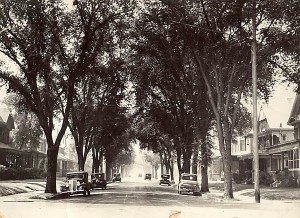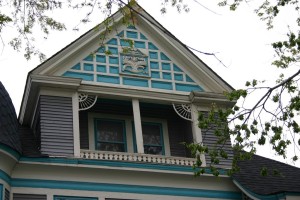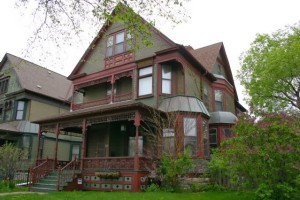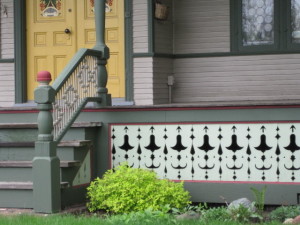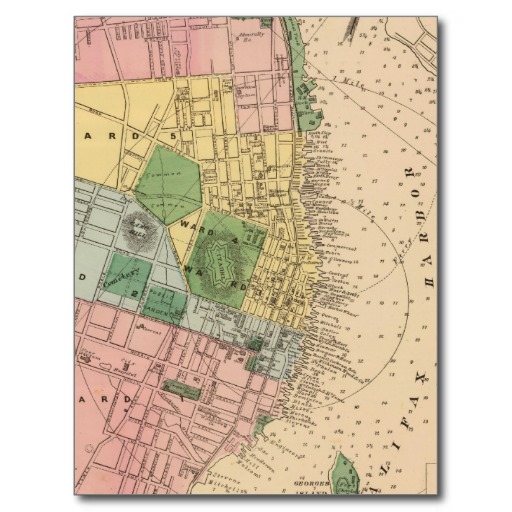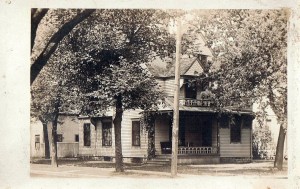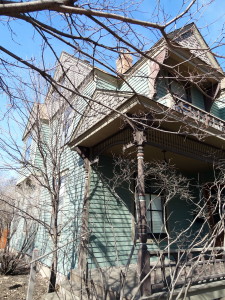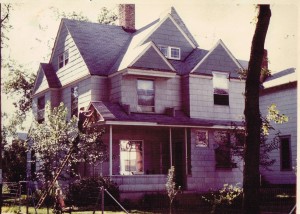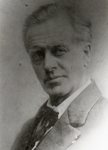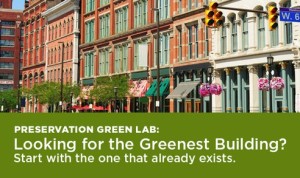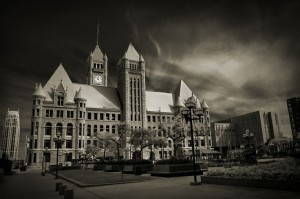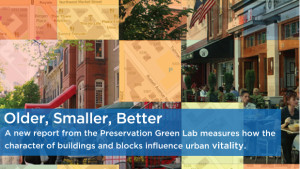
Welcome to the
Healy Project
Join us on Facebook
Send us an Email
Big Win for Healy Block Residents: Revised I-35W Expansion Plan
Great news for Healy’s most famous Queen Anne houses: On Monday evening, March 23rd, at a meeting held by Hennepin County and the City of Minneapolis with residents of the Healy Block Historic District, the proposed sound wall was defeated by unanimous vote among those residents present. In addition, a new proposed design for the I-35W expansion was presented and approved. Monday’s win for the Block is an inspiration for the preservation community: an example of how historic district residents can triumph during a long and challenging political process.
Plans for expanding and redesigning I-35W at the 31st Street exit have been in the works for a long time. Since the early 1990s, various plans have come and gone, representing serious threats to the Healy Block. In their current manifestation, expansion plans were introduced more than four years ago. Negotiation and discussion between the various government entities (federal, state, county and local) and the Block residents have been going on since then. (See post Threats to Healy Houses Renewed) Over a year ago Block representatives met with MNDOT commissioner Charles Zelle to work out some of the issues with the design. The new design and the nixing of the sound wall represent a significant win for livability of the residents on the Block and the future preservation of these historic houses.
David Piehl, who owns and lives in the J.B Hudson House on the Block, explains why eliminating the sound wall from the expansion plans is important: “A wall would be ugly, and the snow storage requirements for the freeway would mean the wall would be 10 feet closer to our homes than it currently is, in addition to being 20 feet high on top of the already-high embankment. Furthermore, the improvement in noise levels was projected to be around 5 decibels, which is not nearly significant enough for us to want to make the other sacrifices the wall would require.”
After the vote on the sound wall, discussion turned to the design of the off-ramp. Residents previously selected a design with a single-lane ramp, separated from Second Avenue by a median. However, the Federal Highway Administration vetoed it as “fatally flawed” due to lack of “storage.” That left another option which was very similar, but had a two-lane ramp.
At the meeting Block residents David Piehl, Ioannis Nompelis, and Pete Holly fought hard to keep the pavement and traffic as far from the historic houses as feasible. Residents recognize that Second Avenue on the 3000-3100 blocks serves three purposes–as a residential street, an off-ramp, and frontage road.
On Monday project organizers presented a modified design that has the ramp starting as single lane, then widening to two. They also widened the median separating Second Avenue from the ramp to 12 feet by taking a portion of the embankment. As Piehl reports, Block residents “are OK with this because it moves green space closer to our homes and the ramp further away. We wanted the median to be wide enough to be planted, so we can plant a visual screen between Second and the ramp, and we got that. A visual screen will also be re-planted on the embankment. The proposed median runs all the way to 31st Street. Second Avenue becomes a single lane with parking, but entirely separate from the ramp south of 31st. Even better, Second at 31st will be ‘right turn only’ due to adding 20 feet of boulevard space in front of the two homes on the 3000 block—which again moves traffic away from those homes, improving livability. The ‘right turn only’ lane reduces the appeal of 2nd Ave as a ‘frontage road’. The upshot is that Second Avenue will be a single lane residential street separated from the ramp by a 12-foot-wide, planted median.”
The miracle is that after four years of negotiating and fighting with the various entities involved in the I-35W expansion, residents of the Healy Block finally got nearly everything they asked for, short of moving the ramp. As Piehl says, “It is amazing to think that they started with bringing the freeway 30 feet closer, and a massive retaining wall–and we got them to a place where the plan is an improvement over what currently exists!”
This is a truly remarkable win for preservation in Minneapolis. Thanks go to a talented city planner, Jeni Hager, who diligently designed, re-designed, and re-designed again to ensure that the current proposal satisfied residents’ aesthetic and livability concerns as well as state and federal requirements. Many thanks also to supportive City Council members Elizabeth Glidden and Alondra Cano for their leadership. And finally, thanks and congratulations to David Piehl, Ioannis Nompelis, Pete Holly, John Cuningham (who worked for moving the ramp) and other Block residents who persevered and made it happen.
and did!
T.B.

Healy’s business was located on Upper Water Street in the Halifax, Nova Scotia, harbor area. Most of the buildings in this 1920s postcard have been razed. By 1886 Healy was building in Minneapolis.
In answer to my inquiry about T.P. Healy, we have received the following e-mail from Garry D. Shutlak, Senior Archivist, Reference Services, Nova Scotia Archives:
“Subject: Theron Potter Healy (1844-1908), farmer, commission merchant & grocer, wholesale grocers, produce and commission active Nova Scotia (1868-1882)
Based on the birth of the children, Mr. Healy left Halifax sometime after 02 June 1882 when daughter Bessie O. Healy was born in Halifax. The family is detailed on www.ancestry.ca
And we have a number of birth and marriage and death records recorded on our web site www.novascotiageneaolgy.com
We searched on-line the Nova Scotia Provincial and Halifax city Directories until Mr. Healy failed to appear.
He is first listed in McAlpine’s Nova Scotia Directory1868/69 aa a farmer in Round Hill Annapolis County He is next listed in the 1871/72 Halifax City Directory Theron P. Healy of Healy, Whitman & Company, commission merchants and grocers, 120 Upper Water Street (Theron P. Healy and John W. Whitman.) The firm becomes T.P. Healy & Company , Theron P. Healy, h 117 Cunard Street in 1879 produce and commission merchants, 116-118 Upper Water Street and last appears in the 1882 McAlpine Halifax City Directory, published the 1 of July, 1882.
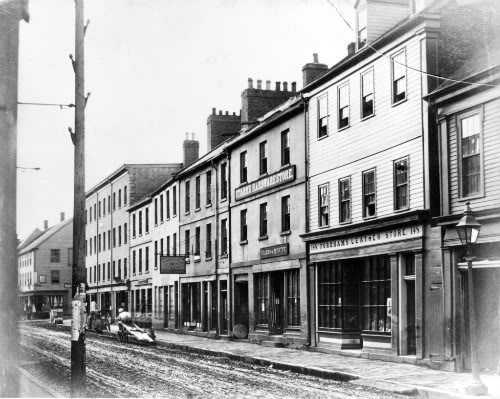
The west side (138-146) Upper Water Street, c.1871. Healy’s business was located further down the block (to the left) at 120. These blocks no longer exist, razed for waterfront redevelopment.
By checking our Registry of Deeds we find that Mr. Healy moved to Halifax sometime after O1 January 1871 and that he was still residing in Halifax on the 03 January 1883 but by 25 June 1883 he was a resident of Minneapolis.
According to the ancestry web site, Mr. Healy had two vessels, the schooners Lina and Mary E. Banks. According to the Shipwreck database on the Maritime Museum of the Atlantic web site, the Mary E. Banks was stranded and became a total loss on the North East Reef, L’Ardoise , 30 August 1883.”
We knew something about Healy’s time in his home village of Round Hill, NS. His brother John’s wife was the former Sara Jane Whitman–which suggests a family connection with Healy’s business partner in Healy, Whitman, and Company. We also knew about the loss of the Mary E. Banks, which, according to Healy’s descendants, ruined him financially and spurred the move to the Midwest.
While this e-mail answers some questions about Healy’s time in Halifax, it deepens the mystery of how Healy made the transition from “farmer, commission merchant, and grocer” to master builder. Did he design and build wooden ships in Nova Scotia? Only further research will tell.
Again, special thanks to Garry D. Shutlak of the Nova Scotia Archives.
–T.B.
An 1885 house will be open to tour on Saturday, April 25th, 1-2 p.m. The Twin Cities Vintage Homes Group is sponsoring the tour, with the proceeds to be donated to the Healy Project.
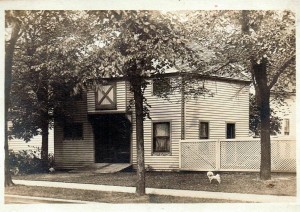
The barn in 1915. The hay mow level was cut off during the 1930s, when the structure was converted into a garage. The little dog, “Taxi”, was the Cartwright family pet.
Sign up for the tour on the Twin Cities Vintage Homes Group Meetup page. Space is limited, so don’t delay. To tour the interior of the house, you must preregister.
(Note: This is not a T.P.Healy design.)
The rectilinear Queen Anne at 2648 Emerson Ave. S. in Minneapolis was designed and built by master builder Charles Johnson Buell. After owner Frank Cartwright died in 1942, the house fell on hard times. The Cartwrights had duplexed it during the Depression. Subsequent owners had painted all the woodwork and added two layers of siding, insulbrick and asbestos shakes.
The current owner acquired the house in 1976, and three years later the exterior restoration began with the removal of the siding.
Damaged clapboard was replaced, and the shingles on the gable ends repaired. Using the 1915 photo, master carpenter Doug Moore reproduced ornaments and trim. The house was painted in multiple historic colors.
The total restoration of the house took place incrementally, over 30 years. The woodwork in eight of the 12 original rooms has been stripped and refinished. In 1996 the summer kitchen was converted into a four-season room and 3/4 bath. Both of the chimneys and the front porch have been rebuilt. The interior restoration was officially declared complete in 2009 with the replication of the fretwork spandrel between the parlors–done by the same carpenter who reproduced the exterior trim in 1979.
The builder, Charles J. Buell, moved to Minneapolis from New York City in 1880. He served as principal of the Whittier School before becoming a builder. He built his first two houses in the Lowry Hill East neighborhood of Minneapolis in 1884; this house, built 1885, is his third. In 1888, he started building in St. Paul. From 1884-1919 Buell built 30 houses, 25 of which are still standing.
Buell Building List (compiled by Anders Christensen):
1884 402 W. Franklin (residence) Mpls.
2521 Aldrich Ave. S. $2,000
2525 Aldrich Ave. S. $2,000
1885 2648 Emerson Ave. S. $5,100
1887 2714 Girard Ave. S. $1,500 W
1888 2177 Commonwealth $5,000 SP
2173 Commonwealth $500
2210 (Langford N.) Hillside $2,400
930 Bayless $7,450 W
1889 2360 Bayless $5.000
2230-32 (Langford N.) Hillside $5,000
2214 (Langford N.) Hillside $2,400
25 Langford Park West $5,000
1890 2223 Knapp $2,450
1094-96 E. Bayless $6,000 W
1891 977 W. Bayless $2,500
2219 Knapp $3,000
1898 1717 Irving Ave. S. Mpls.
1901 1859 Dayton $3,500 SP
1902 1791 Dayton $2,000
1905 2308 Commonwealth $3,500
1906 1879 Dayton $4.250
1541 Ashland $4,500
1909 1549 Ashland $4.250
1550 Laurel $5,000
1910 1546 Laurel $4,000
1534 Laurel $4,500
1911 1514 Ashland $3,500
1913 1540 Ashland $3,500 W
1528 Laurel $5,000
1915 4748 Bryant $5,000 Mpls.
4744 Bryant
1919 2173 Commonwealth $3,200 SP
TB
Last Friday Minneapolis Mayor Betsy Hodges went on her political Facebook page to take Nicole Curtis to task for her criticism of City Council members. Curtis, the “Rehab Addict” had criticized City officials on her Facebook page for their failure to answer to the corrupted process that led to the demolition of the Orth House on February 25th. Since then, an all-out slugfest has ensued on social media, distracting people from the issue of the lying that went on in public hearings and in District Court about the condition of the Orth House. (See previous posts on this blog.)
Let’s turn our attention away from the demolished Orth House. Let’s cut through the smokescreen issuing from City Hall and focus upon the corrupted process of testimony that brought down the house. Mayor Hodges and CM Bender need to stop pitying themselves and do some explaining about the lack of integrity in the process of testimony before the City Council. Their attack on Curtis, a resident of CM Bender’s ward, is nothing short of self-serving meanness.
Curtis is not just a media star; she is a Minneapolis taxpayer. City officials going after a constituent-critic on social media is unethical, to say the least. Hodges and Bender have gone so far as to kick constituent-critics off their Facebook pages. Democracy in action? If city officials attacked a developer the way they are attacking their own constituents, they’d be slapped with a lawsuit so fast their heads would spin. Apparently, they think it’s OK for those in power to go after private citizens. There oughta be a law. Well, in fact, there is. It’s called the City’s Code of Ethics.
If the goal of these elected officials is to silence their critics, they are not doing a very good job of it. People don’t like feeling shut out of expressing their views to those who represent them. People like even less being fed a load of blather generated from lies as answer to their concerns. 
For the record:
1. The owner of the Orth House filed an appeal to demolish an historic resource. Hodges voted to make it an historic resource in 2013. It became no less historic after CM Bender took office.
To reiterate from a previous post: “At the appeal hearing chaired by CM Bender, both Michael Crow (owner) and John Smoley (Planning staffer) were allowed presentations in favor of demolition. The HPC’s position was reported but not presented; reporting is not a substitute for a persuasive presentation earnestly defending the HPC’s position. It seems appropriate that some provision be made in cases which staff’s professional opinion differs from the decision-making making body.
Something is amiss when the recommendations of both presentations are in agreement with one another. By definition, an appeal is a scenario where one opinion is not in agreement with another.”
In their own defense, City officials trot out the judge’s findings on the Healy Project’s MERA lawsuit to stop the demolition of an historic resource. These findings, like the City Council’s 11-2 vote to demolish the Orth House, were based on false testimony. The lies continue.
2. Mayor Hodges cites a post from a local blogger to document the vulgar comments being made about CM Bender. It turns out that these comments were cut out of threads of many hundreds of comments on Curtis’s “Rehab Addict” Facebook page. Citing this blogger as a credible source of information is like citing Glenn Beck as proof that Obama wasn’t born in the US.
The Twitter feed from this blogger is a nonstop tirade of name-calling against CM Bender’s detractors, including members of the Healy Project. Last year, the blogger doxed Curtis, a single mother. This is as low as you can go. Doxing is a tactic used to threaten and silence women (primarily), so the Twitterer pretending he’s protecting CM Bender from gendered attacks is total hogwash.
The Healy Project conceded that the house’s demolition was a determined matter. We hoped that the process issues could be examined separately from one’s feelings or opinions about the house. CM Bender’s response via posting on Facebook a decision based on the corrupted testimony is a distraction from our inquiry for examination of protocol and process. It’s time for City officials to stop grandstanding and start talking to Minneapolis citizens.
Elected City officials should not be fueling vitriol against their own constituents. If they’re so thin-skinned, they should consider new career paths. Let’s take the “discussion,”if it can be dignified with the term, off Facebook and Twitter and turn to addressing the issue of corrupted testimony. To refuse to do so undermines the public trust.
Until city officials get serious about examining this process, Mayor Hodges, CM Bender, and other officials will have no credibility with many of their constituents.
Their attack on Nicole Curtis has become a national story. Their foolish social media campaign against her has made Minneapolis into a laughingstock.
In January of last year: A political dogfight breaks out in New Jersey after one of the governor’s aides initiated “traffic problems” on a commuter bridge. The issue behind the controversy was lucrative development contracts (what else?). An all-out battle ensued involving the governors of NY, NJ, the Port Authority, and mayors in NJ cities. It was brutal. However, not once did any of them complain that their feelings had been hurt by their political opponents.
No problem was ever solved when those in power refused to sit down and talk. Come on, Mayor Hodges and CM Bender. Get off the low road of social media and get down to fixing problems and moving ahead.
T.B.
